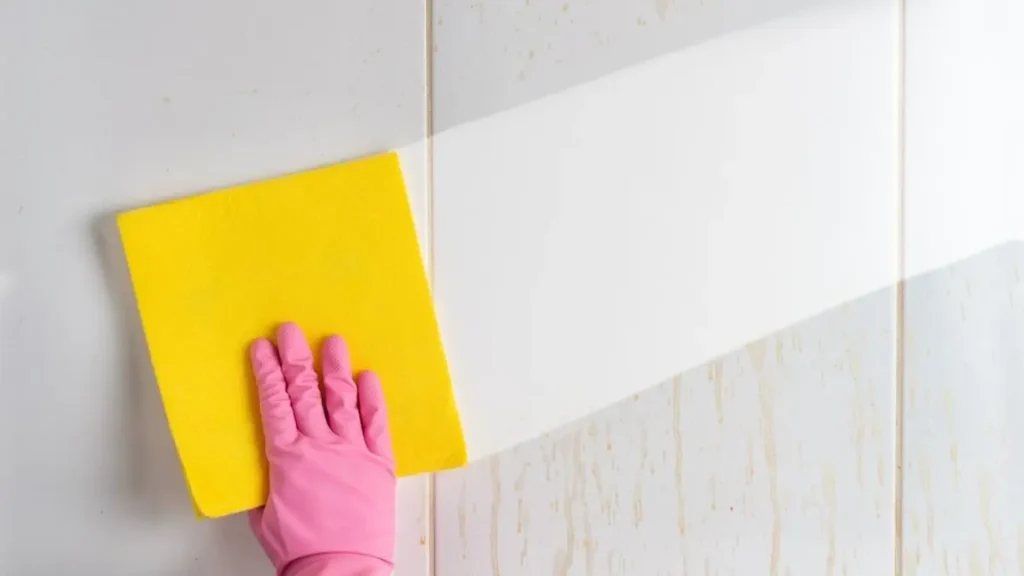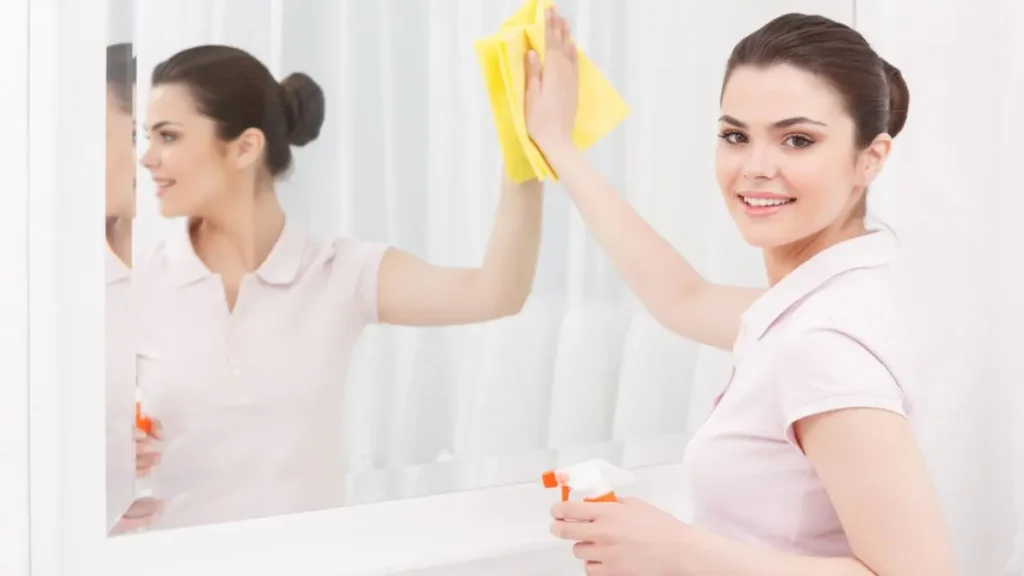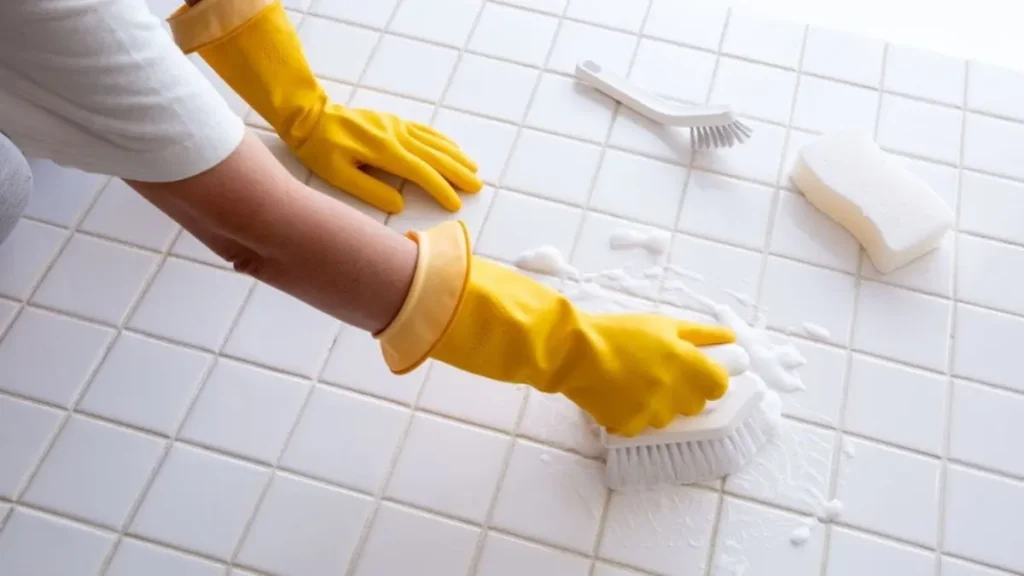A clean bathroom is essential for maintaining both hygiene and comfort in your home. Regular cleaning not only prevents the buildup of dirt and grime but also reduces the risk of bacteria and mold growth—two common causes of health issues like allergies and respiratory problems.
Keeping your bathroom spotless also helps prolong the life of your fixtures, such as faucets, tiles, and mirrors, by preventing hard water stains and soap scum from becoming permanent.
Bathrooms are one of the most frequently used areas in any home. A well-maintained bathroom promotes a pleasant, odor-free environment and reflects positively on your overall living space.
Whether you have guests over or simply want a more relaxing experience after a long day, a clean bathroom contributes to a fresher, more inviting atmosphere. Maintaining cleanliness also helps you avoid costly repairs in the long run, as regular care prevents the need for extensive deep cleaning or replacement of damaged surfaces.
With the right cleaning routine, your bathroom can stay hygienic and visually appealing all year round. In this guide, we’ll explore essential cleaning tips to tackle each part of your bathroom, from grout and glass to faucets and floors, ensuring you achieve a spotless result every time.
Grout Cleaning: Say Goodbye to Stubborn Stains

Grout is often one of the most overlooked areas during bathroom cleaning, yet it plays a critical role in keeping your bathroom looking fresh and hygienic. Over time, grout lines between tiles accumulate dirt, mold, and mildew, leading to unsightly stains that can be difficult to remove. Proper grout cleaning not only enhances the appearance of your bathroom but also prevents mold and bacteria from thriving in damp environments.
Explore effective methods to clean grout, the best products to use, and expert techniques to keep your grout lines looking like new.
Why is Grout So Hard to Clean?
Grout is a porous material, which means it easily absorbs water, dirt, and grime. Unlike tiles, which have smooth, non-porous surfaces, grout can trap particles and moisture deep within its surface, making it a breeding ground for mold and mildew.
Grout also tends to discolor over time, especially in areas exposed to frequent moisture, like showers and floors near sinks. The constant buildup of soap scum, mineral deposits from hard water, and everyday dirt contribute to the challenge of keeping grout clean.
However, with the right approach, even the toughest stains can be eliminated, restoring your grout to its original color and preventing future buildup.
What Products Work Best for Grout Cleaning?
When it comes to grout cleaning, using the right products is essential to achieve optimal results without damaging the material. Grout cleaners specifically formulated for bathroom use are highly effective at breaking down dirt, mold, and mildew.
Many of these products contain bleach or other whitening agents to help restore the original brightness of your grout. However, if you’re dealing with sensitive surfaces or prefer eco-friendly alternatives, vinegar and baking soda are excellent natural solutions.
Oxygenated bleach is another popular option for tackling stubborn grout stains. This type of cleaner is gentle enough to avoid damaging grout but strong enough to lift deep stains and kill mold spores.
If your grout is particularly dirty or discolored, you may need a stronger commercial grout cleaner or a heavy-duty tile and grout cleaner, which is specifically designed to penetrate porous surfaces and remove embedded grime.
How to Clean Grout: Step-by-Step Guide
Cleaning grout requires a systematic approach to ensure that you thoroughly remove dirt and mold without causing damage. The following method can help you restore your grout to its original condition:
- Prepare the Area: Before cleaning, remove any loose debris or dust from the grout lines. This can be done by sweeping or vacuuming the area, ensuring there is no dirt that could scratch the tiles during cleaning.
- Apply Grout Cleaner: Spray or apply your chosen grout cleaner directly onto the grout lines. For natural cleaning solutions like vinegar or baking soda, you can either spray vinegar onto the grout or create a paste with baking soda and water to apply to the grout lines. Allow the cleaner to sit for about 10 to 15 minutes, giving it time to break down stains and grime.
- Scrub the Grout: Use a stiff-bristled grout brush or an old toothbrush to scrub the grout. Be sure to focus on heavily stained areas, applying extra pressure to lift deep-seated dirt. Scrubbing in a circular motion often yields the best results, as it helps work the cleaner into the grout pores. For stubborn stains, you may need to reapply the cleaner and scrub again.
- Rinse the Area: After scrubbing, rinse the area with warm water to wash away any residue from the cleaner. Use a damp microfiber cloth or sponge to wipe away excess water and cleaner, ensuring that no residue is left behind on your tiles.
- Dry Thoroughly: After cleaning, it’s important to dry the area completely to prevent moisture from settling back into the grout, which can lead to mold regrowth. Use a dry towel or a squeegee to remove any remaining water.
How Often Should You Clean Your Grout?
Regular grout cleaning is essential to prevent the buildup of dirt and mold. The frequency of cleaning depends on how often your bathroom is used and how quickly grime accumulates.
For heavily used bathrooms, cleaning grout every one to two weeks is ideal. However, for areas that don’t see as much moisture or foot traffic, monthly cleaning may suffice.
Additionally, it’s important to seal your grout every six months to a year. Grout sealers create a protective barrier that helps repel moisture and stains, making future cleaning easier and more effective. Sealing also reduces the likelihood of mold and mildew forming in your grout lines, keeping your bathroom cleaner for longer periods.
Expert Tip: Preventing Future Grout Stains
To minimize grout stains and reduce the amount of cleaning required, there are a few preventive measures you can take. Ventilating your bathroom after showers or baths helps reduce moisture levels, which in turn reduces the risk of mold and mildew developing in grout lines. Installing a high-quality exhaust fan or leaving windows open can help keep humidity at bay.
Another simple but effective tip is to wipe down your tiles and grout after every use. Using a squeegee to remove excess water from your shower walls and floor will significantly reduce water buildup, soap scum, and mineral deposits.
Glass and Mirrors: Keeping Surfaces Spotless

Glass and mirrors are common features in bathrooms, enhancing the overall aesthetic and making spaces feel larger and brighter. However, these surfaces are prone to fingerprints, water spots, and soap scum, which can detract from their appearance. Maintaining spotless glass and mirrors is essential for a polished and inviting bathroom environment.
Why Glass and Mirrors Require Special Care
Glass and mirrors can be susceptible to streaks, smudges, and mineral deposits from hard water, making them appear dirty even shortly after cleaning. The reflective nature of these surfaces means that any blemish or imperfection is easily noticeable.
In addition, cleaning products that are too harsh can cause scratching or damage to the surface, leading to a dull appearance. Using appropriate cleaning techniques and products ensures that glass and mirrors remain clear and in good condition, enhancing the overall look of the bathroom.
Recommended Cleaning Products for Glass and Mirrors
When it comes to cleaning glass and mirrors, using the right products is vital for achieving a streak-free finish. Glass cleaners specifically formulated for use in bathrooms are often the most effective choice, as they are designed to break down soap scum, water spots, and grime without leaving behind residue. Look for cleaners that contain ammonia-free formulas to avoid potential damage to certain mirror coatings and frames.
For a more natural approach, a solution of equal parts water and white vinegar can be used to effectively clean glass and mirrors. Vinegar is a powerful cleaning agent that can dissolve mineral deposits and eliminate odors, making it an excellent choice for maintaining spotless surfaces. Microfiber cloths are ideal for applying cleaners, as they are soft, non-abrasive, and highly effective at trapping dirt without scratching the surface.
Step-by-Step Guide to Cleaning Glass and Mirrors
Cleaning glass and mirrors can be straightforward if you follow a systematic approach. To achieve optimal results, consider these steps:
Begin by ensuring the surface is free of loose dust and debris. Use a dry microfiber cloth to wipe away any particles from the glass or mirror. This step is crucial to prevent scratches during the cleaning process.
Next, apply your chosen glass cleaner or the vinegar solution directly onto the surface. It is advisable to use a fine mist spray, which allows for even distribution of the cleaner. If using vinegar, dampen the microfiber cloth with the solution rather than spraying directly onto the glass, as this helps prevent overspray on surrounding areas.
With the cleaner applied, take a clean, dry microfiber cloth or a squeegee to wipe the glass or mirror. For mirrors, use vertical strokes for one half and horizontal strokes for the other half. This technique helps to quickly identify any streaks that may remain, allowing for targeted cleaning.
If necessary, repeat the cleaning process on particularly stubborn spots or streaks. For heavy soap scum or mineral deposits, applying a paste of baking soda and water can be beneficial. Rub the paste on the affected areas with a soft cloth, then rinse and dry thoroughly.
How Often Should You Clean Glass and Mirrors?
The frequency of cleaning glass and mirrors in your bathroom largely depends on usage and exposure to moisture. For high-traffic bathrooms, cleaning mirrors and glass surfaces at least once a week is recommended. In less frequently used bathrooms, a monthly cleaning routine may suffice.
To minimize the frequency of deep cleanings, consider implementing quick daily maintenance. After showering, using a squeegee to wipe down the glass can effectively reduce the buildup of water spots and soap scum. Additionally, keeping a microfiber cloth handy for quick touch-ups can help maintain a spotless appearance between more thorough cleanings.
Expert Tips for Maintaining Glass and Mirrors
To keep glass and mirrors in pristine condition, there are a few expert tips to consider. Avoid cleaning on sunny days, as direct sunlight can cause cleaning products to dry too quickly, leading to streaks. Instead, choose a cloudy day or clean during the evening when sunlight is not directly hitting the surfaces.
Using a dedicated glass cleaning tool can also make the process easier and more efficient. These tools often feature ergonomic designs and specialized materials that prevent scratching while providing an effective clean.
Finally, for mirrors, regularly check for silvering on the back of the mirror. If you notice discoloration or damage, it may be time to replace the mirror to maintain a clear reflection. These maintenance tips and utilizing the right products and techniques, you can ensure that your bathroom’s glass and mirrors remain spotless and inviting.
Faucet and Fixture Cleaning: Shine Like New

Faucets and fixtures play a crucial role in the functionality and aesthetic appeal of a bathroom. Over time, they can accumulate mineral deposits, soap scum, and grime, diminishing their shine and leading to unsightly stains.
Cleaning these surfaces is essential not only for maintaining their appearance but also for prolonging their lifespan.
The Importance of Regular Faucet and Fixture Maintenance
Regular cleaning of faucets and fixtures is vital for several reasons. First, mineral buildup from hard water can lead to corrosion and tarnishing if left unchecked. This buildup can affect the performance of the fixtures, leading to leaks or decreased water flow.
Second, clean fixtures contribute to a polished bathroom appearance, enhancing the overall atmosphere of the space. A well-maintained faucet not only looks appealing but also reflects a commitment to cleanliness and hygiene.
Recommended Cleaning Products for Faucets and Fixtures
To achieve a sparkling finish, it is important to use the right cleaning products tailored to the specific materials of your faucets and fixtures. Most faucets are made from chrome, stainless steel, or brass, each requiring specific care.
For chrome faucets, a gentle liquid dish soap mixed with warm water is often sufficient for regular cleaning. This solution effectively removes dirt and soap scum without damaging the finish. For tougher stains, a specialized chrome cleaner can be beneficial. These products are designed to enhance the shine and protect against tarnishing.
Stainless steel fixtures also require a gentle touch. Use a mild detergent or a cleaner specifically formulated for stainless steel. Avoid abrasive pads, as they can scratch the surface. Instead, opt for a soft cloth or sponge for application.
Brass faucets may require a different approach. Since brass can tarnish over time, a mixture of vinegar and baking soda can be effective. This solution removes tarnish while restoring the brass’s natural luster. After cleaning, rinse thoroughly and dry with a soft cloth to prevent water spots.
Step-by-Step Guide to Cleaning Faucets and Fixtures
Cleaning faucets and fixtures can be accomplished with a systematic approach. Start by gathering your cleaning materials, which should include your chosen cleaner, a soft cloth, and a sponge. For stubborn deposits, a soft-bristled toothbrush may be useful for scrubbing hard-to-reach areas.
Begin by applying your cleaning solution directly to the faucet or fixture. If using a spray cleaner, mist it onto the surface. For vinegar and baking soda mixtures, apply the paste directly to the tarnished areas. Allow the solution to sit for a few minutes to break down any buildup.
Using a soft cloth or sponge, gently scrub the surface in circular motions. Pay special attention to areas around the handles and spouts, where grime tends to accumulate. For tight spaces, such as the base of the faucet, a soft-bristled toothbrush can help dislodge dirt without scratching the surface.
After scrubbing, rinse the faucet or fixture with warm water to remove any residue from the cleaning solution. Finally, dry the surface thoroughly with a clean, soft cloth to prevent water spots and maintain a shine.
How Often Should You Clean Faucets and Fixtures?
The frequency of cleaning your faucets and fixtures will depend on several factors, including usage and water quality. In high-traffic bathrooms, it is advisable to clean faucets and fixtures weekly to prevent buildup. In less frequently used bathrooms, a bi-weekly cleaning schedule may be adequate.
To keep fixtures looking their best between cleanings, consider wiping them down daily with a damp microfiber cloth. This quick maintenance step can effectively reduce the accumulation of soap scum and mineral deposits.
Expert Tips for Maintaining the Shine of Faucets and Fixtures
To maintain the shine of your faucets and fixtures, there are a few expert tips to consider. First, avoid using harsh chemicals or abrasive materials, as they can scratch and damage the finish. Instead, opt for gentle cleaners that are specifically formulated for the materials used in your fixtures.
Second, regular inspections can help identify potential issues before they escalate. Check for signs of corrosion, rust, or mineral buildup and address them promptly. Addressing these issues early can help maintain the functionality and appearance of your fixtures.
Lastly, consider applying a protective coating to chrome or stainless steel fixtures. Products designed for this purpose can create a barrier against water spots and stains, making regular cleaning easier.
These cleaning methods and maintenance tips, you can ensure that your bathroom faucets and fixtures remain shiny and inviting, contributing to the overall cleanliness and appeal of your space.
Bathroom Floor Cleaning: Keep It Clean and Hygienic

Bathroom floors are often subjected to high moisture levels, dirt, and grime, making regular cleaning essential for both hygiene and aesthetics. Whether your bathroom floor is tiled, vinyl, or made of another material, maintaining a clean surface contributes significantly to the overall cleanliness of your bathroom. Explore effective cleaning techniques, suitable products, and expert tips to ensure your bathroom floors remain clean and hygienic.
Importance of Regular Bathroom Floor Cleaning
Regular cleaning of bathroom floors is critical for several reasons. Firstly, floors accumulate dirt, hair, soap residue, and other debris, creating an unhygienic environment. Bacteria and mold can thrive in damp areas, posing health risks to occupants.
Secondly, clean floors enhance the visual appeal of the bathroom. A well-maintained floor can significantly elevate the overall ambiance and contribute to a more relaxing and inviting atmosphere.
Recommended Cleaning Products for Bathroom Floors
Selecting the appropriate cleaning products is crucial for effective bathroom floor cleaning. The type of flooring material largely determines the cleaning solutions to use. For ceramic or porcelain tiles, a mild detergent diluted in warm water can be very effective. Commercial tile cleaners are also available and can help remove tough stains and soap scum.
If your bathroom floor is vinyl, it is essential to use a cleaner specifically formulated for vinyl surfaces. Avoid harsh chemicals that can damage the vinyl. A simple mixture of white vinegar and water is an excellent natural alternative that cleans effectively without causing harm.
For natural stone floors, such as granite or marble, it is vital to use pH-neutral cleaners. Acidic cleaners can damage the stone’s finish. Specialized stone cleaners are widely available and can provide a deep clean while protecting the integrity of the surface.
Step-by-Step Guide to Cleaning Bathroom Floors
Cleaning your bathroom floor effectively requires a systematic approach. Start by removing any loose debris. Sweep or vacuum the floor to eliminate hair, dust, and dirt. This step prepares the surface for deeper cleaning.
Next, prepare your cleaning solution. If using a commercial cleaner, follow the instructions on the label for dilution. If opting for a homemade solution, mix warm water with your chosen cleaner. For vinyl, a vinegar-water solution works well. For tile, a mild detergent will suffice.
Once your cleaning solution is ready, apply it to the floor using a mop or cloth. For tough stains or areas with heavy buildup, consider using a soft-bristle brush to scrub the surface. Work in sections to ensure that each area receives adequate attention.
After scrubbing, allow the cleaning solution to sit for a few minutes to penetrate and break down grime. Rinse the floor thoroughly with clean water to remove any cleaning solution residue. This step is particularly important for vinyl, as leftover cleaner can lead to a slippery surface.
Finally, dry the floor using a clean, dry mop or towels. Ensuring the floor is dry helps prevent slips and falls while also discouraging mold growth in damp areas.
How Often Should You Clean Bathroom Floors?
The frequency of bathroom floor cleaning depends on usage and environmental factors. In high-traffic bathrooms, cleaning should be done at least once a week to manage dirt and moisture effectively. For less frequently used bathrooms, bi-weekly cleaning may be adequate.
In addition to regular deep cleaning, consider implementing a quick daily maintenance routine. This could involve sweeping or vacuuming the floor to prevent dirt from accumulating. Wiping down the floor with a damp cloth can also help remove any spills or stains before they set in.
Expert Tips for Maintaining a Clean Bathroom Floor
To maintain a clean and hygienic bathroom floor, several expert tips can be beneficial. Firstly, consider placing mats or rugs at entry points to catch dirt and moisture before they reach the floor. Wash these mats regularly to prevent them from becoming sources of dirt themselves.
Secondly, invest in a good-quality mop that is suitable for your flooring type. A microfiber mop can be particularly effective for picking up dust and dirt while minimizing the need for harsh chemicals.
Lastly, keep an eye on moisture levels in the bathroom. Use exhaust fans during and after showers to reduce humidity, as this will help prevent mold and mildew growth on floors and walls. Proper ventilation is key to maintaining a hygienic environment.
These cleaning techniques and maintenance tips, you can ensure that your bathroom floors remain clean and hygienic, significantly enhancing the overall cleanliness and appeal of your bathroom space.
Expert Tips for Maintaining a Spotless Bathroom

Maintaining a spotless bathroom requires consistent effort and strategic practices. By adopting a few expert tips and integrating them into your cleaning routine, you can ensure that your bathroom remains not only clean but also welcoming.
Daily Habits for a Clean Bathroom
Establishing daily habits can significantly reduce the workload when it comes to deep cleaning your bathroom. A few minutes each day dedicated to maintenance can keep surfaces fresh and minimize the accumulation of dirt and grime.
Begin by making it a habit to wipe down surfaces after each use. This includes sinks, countertops, and faucets. Use a damp cloth or a disinfectant wipe to remove soap residue, toothpaste, and water spots. Quick cleanings prevent these residues from hardening into stubborn stains that require more effort to remove later.
Additionally, consider giving the toilet a quick scrub daily. Keeping a toilet brush and cleaner accessible can make this task more convenient. A few swipes around the bowl can keep bacteria at bay and maintain a fresh appearance.
Another important daily practice is to check for clutter. Take a moment to put away personal items like toiletries and towels after each use. This not only keeps the bathroom looking tidy but also makes cleaning easier, as fewer items will need to be moved during your cleaning routine.
Weekly Maintenance Routines
In addition to daily habits, establishing a weekly maintenance routine is crucial for a spotless bathroom. This routine should include thorough cleaning of all surfaces, including mirrors, fixtures, and floors.
Start with dusting and wiping surfaces using a suitable cleaner. Pay special attention to often-overlooked areas such as light fixtures and the tops of cabinets. For mirrors, use a glass cleaner to achieve a streak-free shine.
Next, dedicate time to cleaning the toilet, ensuring that both the inside and outside are spotless. This includes scrubbing the bowl and wiping down the exterior, including the handle and surrounding areas.
Finally, focus on the floor. As discussed in previous sections, a thorough cleaning of the bathroom floor helps to eliminate dirt and grime buildup. Weekly maintenance is also an opportunity to check the grout for stains or discoloration and treat them accordingly.
Seasonal Deep Cleaning Strategies
While weekly maintenance helps to keep your bathroom in good condition, seasonal deep cleaning is essential for addressing areas that require more attention. At least once every few months, allocate time for a comprehensive cleaning of the bathroom.
During a seasonal deep clean, focus on removing any mildew or mold that may have developed in damp areas. Use specialized mildew removers or a mixture of bleach and water to treat affected surfaces, ensuring proper ventilation during the process.
Another critical aspect of seasonal cleaning is to check and refresh storage areas. This includes cleaning out cabinets and drawers, discarding expired products, and organizing remaining items. A tidy storage space not only looks better but also makes it easier to locate essential items when needed.
Lastly, pay attention to the condition of bathroom accessories. Check for wear and tear on towels, bath mats, and shower curtains, and replace them as needed. Fresh accessories can significantly enhance the overall appearance of the bathroom.
Proactive Measures to Prevent Grime Buildup
Preventing grime buildup in the bathroom is often more effective than cleaning it later. Install a squeegee in the shower to remove water from tiles and glass after each use. This simple step helps reduce soap scum and hard water stains, making regular cleaning easier.
Consider using bathroom-specific air fresheners or dehumidifiers to combat moisture, which can promote mold growth. Keeping humidity levels low can also help maintain a fresher atmosphere in your bathroom.
Another effective measure is to choose the right cleaning products. Opt for multi-surface cleaners that are safe for various materials in your bathroom. These products can save time and effort while ensuring effective cleaning results.
Lastly, regularly inspect and maintain plumbing fixtures to prevent leaks. Small leaks can lead to significant water damage and promote mold growth, so addressing them promptly is essential for maintaining a clean and healthy bathroom environment.
Integrating these expert tips into your cleaning routine, you can maintain a spotless bathroom that is both functional and aesthetically pleasing. Regular maintenance, proactive measures, and seasonal deep cleaning will help ensure your bathroom remains a clean and inviting space.
Recommended Cleaning Products for a Sparkling Bathroom

Choosing the right cleaning products is essential for achieving a sparkling bathroom. The effectiveness of these products can make a significant difference in how easily and efficiently you can clean various surfaces. This section will outline some recommended cleaning products tailored for different areas of the bathroom, ensuring you have the right tools for the job.
All-Purpose Cleaners
An all-purpose cleaner is a fundamental product for maintaining a clean bathroom. These versatile cleaners can be used on multiple surfaces, including countertops, sinks, and fixtures.
Look for an all-purpose cleaner that contains disinfectant properties to eliminate germs and bacteria effectively. Many products are available in spray form for easy application, and some even come in eco-friendly versions that are safe for both users and the environment.
For tough stains, consider a concentrated formula that can be diluted with water to tackle more significant cleaning tasks while still being gentle enough for daily use.
Grout Cleaners
Grout can be a stubborn area to clean, requiring specialized products designed to penetrate and lift stains. A good grout cleaner should contain a blend of strong cleaning agents, such as bleach or hydrogen peroxide, which can effectively break down mildew, mold, and grime.
When selecting a grout cleaner, consider using one with a narrow applicator or brush to precisely target the grout lines, ensuring that the product reaches all crevices.
For those who prefer a more natural approach, vinegar and baking soda can also serve as effective alternatives. A paste made from these ingredients can help lift stains when applied to the grout and left to sit before scrubbing.
Glass Cleaners
Keeping glass surfaces spotless requires a reliable glass cleaner. A good glass cleaner should provide a streak-free shine while effectively removing water spots and soap scum.
Many commercial glass cleaners are available in aerosol or spray bottles, offering convenience and ease of use. When choosing a product, look for one that contains ammonia or alcohol, as these ingredients enhance cleaning power and evaporation speed, preventing streaks.
For a more eco-friendly option, a mixture of vinegar and water can be used as a homemade glass cleaner. This solution not only cleans effectively but also eliminates odors, leaving your bathroom smelling fresh.
Toilet Cleaners
Toilet cleaners are designed specifically to tackle the unique challenges of toilet cleaning. A quality toilet bowl cleaner should contain powerful ingredients to dissolve hard water stains, mineral deposits, and bacteria. Most toilet cleaners are available in gel or liquid form, allowing for precise application under the rim and around the bowl.
For added convenience, consider using toilet cleaning tablets that can be dropped into the tank. These tablets release cleaning agents with each flush, helping to maintain a cleaner toilet with minimal effort.
Floor Cleaners
Bathroom floors require a cleaner that is effective yet gentle enough not to damage the surface. For tile or vinyl floors, choose a cleaner specifically formulated for these materials to avoid dulling the finish. Many floor cleaners are available in concentrated formulas that can be mixed with water, allowing for customizable cleaning strength.
When selecting a floor cleaner, consider one that offers disinfecting properties to eliminate germs. For an eco-friendly approach, a mixture of vinegar and water can also be effective in cleaning and deodorizing bathroom floors.
Specialty Products for Fixtures
To keep faucets and other metal fixtures looking new, specialty products designed for metals can make a notable difference. Look for a cleaner that is safe for chrome, stainless steel, or brass, depending on the materials in your bathroom. These cleaners not only remove water spots and soap scum but also provide a protective layer that helps prevent future stains and tarnishing.
Additionally, consider using a microfiber cloth for polishing fixtures after cleaning. Microfiber is highly effective at trapping dirt and dust without scratching surfaces, ensuring that your fixtures maintain their shine.
Eco-Friendly Options
For those seeking to reduce their environmental impact, several eco-friendly cleaning products are available. These products typically contain natural ingredients that are effective against dirt and bacteria while being safe for the environment. Look for biodegradable formulas and packaging made from recycled materials to further reduce waste.
DIY cleaning solutions, such as vinegar, baking soda, and lemon juice, also offer effective cleaning without harsh chemicals. These natural ingredients can tackle various cleaning tasks while ensuring a safer bathroom environment.
Selecting the right cleaning products, you can effectively maintain a sparkling bathroom while ensuring the safety and integrity of your surfaces. Each category of products plays a crucial role in achieving a clean and hygienic space, making the cleaning process more efficient and manageable.
Common Bathroom Cleaning Mistakes to Avoid
While cleaning the bathroom may seem straightforward, several common mistakes can hinder your efforts and lead to suboptimal results. By understanding and avoiding these pitfalls, you can ensure a more effective and efficient cleaning routine.
Neglecting to Read Labels
One significant mistake people often make is neglecting to read the labels on cleaning products. Each product is formulated for specific surfaces and types of grime. Using a cleaner that is not suitable for a particular surface can result in damage or ineffective cleaning.
For example, acidic cleaners can harm natural stone surfaces, while abrasive scrubs may scratch delicate finishes. Always take the time to read and follow the manufacturer’s instructions to ensure safe and effective use.
Skipping Regular Maintenance
Another common mistake is neglecting regular maintenance. Many individuals wait until their bathroom is visibly dirty before cleaning. However, routine maintenance can prevent the buildup of dirt, grime, and mildew, making cleaning easier and more effective. Establishing a regular cleaning schedule—such as weekly or bi-weekly—helps maintain a fresh and hygienic bathroom.
In addition, simple daily habits, such as wiping down surfaces after use or using a squeegee on glass shower doors, can significantly reduce the amount of deep cleaning required over time.
Using the Wrong Tools
Using inappropriate tools for cleaning tasks can lead to less effective results and potential damage. For instance, using a rough sponge or steel wool on glass surfaces can scratch them, while a stiff brush may damage grout lines.
It is essential to use the right tools for each job, such as microfiber cloths for glass, soft sponges for delicate surfaces, and brushes specifically designed for grout. Having the appropriate tools at hand can make your cleaning routine more efficient and preserve the integrity of your bathroom fixtures.
Overusing Cleaning Products
Another frequent mistake is overusing cleaning products. Many people believe that using more product will yield better results, but this is often not the case. Excess product can leave behind residues, leading to streaks or a grimy appearance after cleaning.
It can also contribute to the buildup of harmful chemicals in the bathroom. Using the recommended amount, as indicated on the product label, will ensure effective cleaning without the need for excess scrubbing or rinsing.
Ignoring Hard-to-Reach Areas
Failing to clean hard-to-reach areas is a common oversight that can result in hidden dirt and bacteria accumulation. Places like behind the toilet, under sinks, and around pipes often get neglected during regular cleaning routines.
To avoid this mistake, make a habit of checking these areas during each cleaning session. Using extension tools or specific brushes can help you reach and thoroughly clean these challenging spots, ensuring a more comprehensive clean.
Cleaning in the Wrong Order
Cleaning the bathroom in the wrong order can also lead to inefficiencies and subpar results. For instance, starting with the floor before cleaning the sink, toilet, and shower can result in dirt and debris falling onto the freshly cleaned floor, necessitating re-cleaning.
It is best to start from the highest surfaces, such as countertops and mirrors, and work your way down to the floor. This way, you can effectively remove dust and debris without needing to clean again.
Not Allowing Products to Sit
Many cleaning products require some time to work effectively. A common mistake is applying a cleaner and immediately wiping it away without allowing it to penetrate and dissolve grime.
For optimal results, read the instructions and let the product sit for the recommended time before scrubbing or rinsing. This ensures that tough stains and buildup are adequately addressed, leading to a cleaner and more hygienic bathroom.
Recognizing and avoiding these common cleaning mistakes, you can enhance your bathroom cleaning routine, leading to better results and a more hygienic environment.
Taking the time to understand the best practices for bathroom cleaning will not only improve the appearance of your space but also contribute to a healthier home.
Recommended: Essential Bathroom Safety Features
Conclusion
A clean bathroom is essential for both hygiene and comfort, making it a space that contributes to the overall well-being of your home. By implementing effective cleaning techniques and utilizing the right products, you can maintain a sparkling and welcoming bathroom environment.
Throughout this guide, we have explored various aspects of bathroom cleaning, including essential tools, specific cleaning methods for grout, glass, faucets, and floors, as well as expert tips for upkeep and common mistakes to avoid. Each section provides valuable insights and practical advice that can be easily incorporated into your cleaning routine.
Remember that consistency is key. Regular maintenance not only makes the cleaning process easier but also helps prevent the buildup of grime and stains. By investing time in proper bathroom care, you can create a space that is not only visually appealing but also hygienic and healthy.
With the right knowledge and practices, achieving and maintaining a spotless bathroom is entirely within reach. Your efforts will not only enhance the functionality of your bathroom but also contribute to a more pleasant and relaxing atmosphere in your home.



